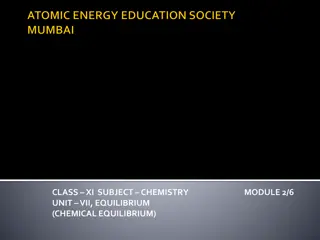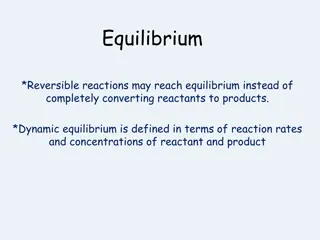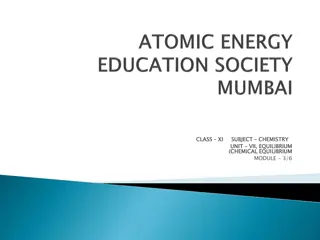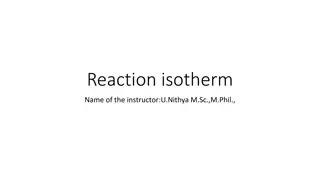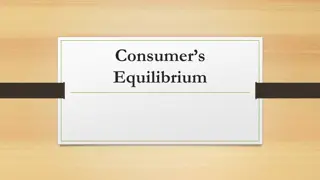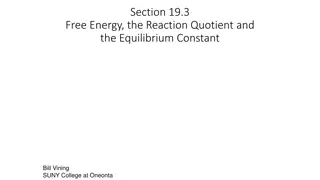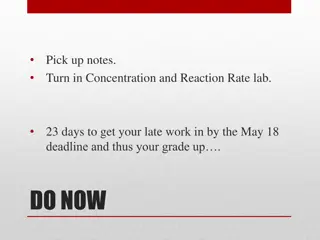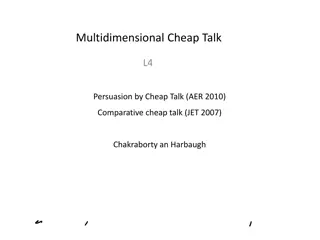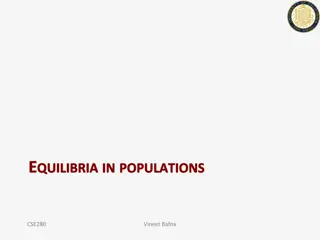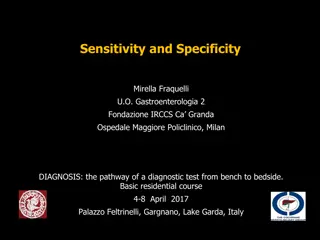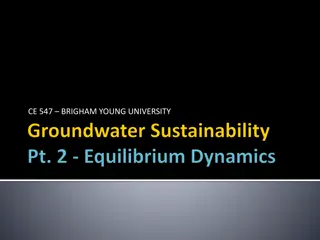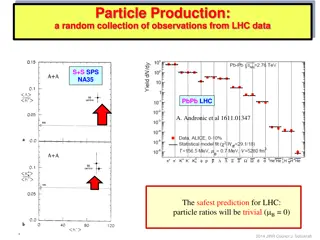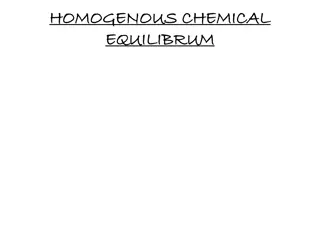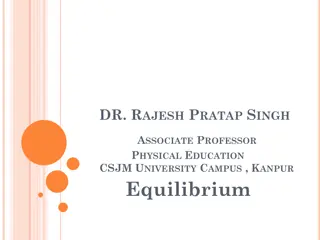Operating high sensitivity measurement apparata out of equilibrium
Operating high sensitivity measurement apparata out of equilibrium presents challenges and opportunities in gravitational wave science and technology. This includes the exploration of equilibrium versus out-of-equilibrium conditions, previous attempts using external feedback, and an analysis of linear coupling to noise and signal in measurement apparatus. The potential for real-time estimation strategies to enhance sensitivity is discussed, highlighting the importance of known transfer characteristics in maximizing measurement accuracy.
Download Presentation

Please find below an Image/Link to download the presentation.
The content on the website is provided AS IS for your information and personal use only. It may not be sold, licensed, or shared on other websites without obtaining consent from the author.If you encounter any issues during the download, it is possible that the publisher has removed the file from their server.
You are allowed to download the files provided on this website for personal or commercial use, subject to the condition that they are used lawfully. All files are the property of their respective owners.
The content on the website is provided AS IS for your information and personal use only. It may not be sold, licensed, or shared on other websites without obtaining consent from the author.
E N D
Presentation Transcript
Operating high sensitivity measurement apparata out of equilibrium Igor Neri with Miquel Lopez-Suarez and Luca Gammaitoni GRAvitational-waves Science&technology Symposium (GRASS 2019) 17-18 October 2019
Equilibrium vs Out-of-equilibrium Most of the noise studies, as well as the operational condition of high sensitivity measurements apparatus (e.g. the G.W. interferometers), are considered under the assumption that the entire system is time quasi- stationary and at thermal equilibrium. This is true even if some of the estimations for some fundamental noises, like thermal noise, have been derived by assuming the validity of fluctuation-dissipation relations that represent the base for non-equilibrium statistical mechanics. A question arises about the possibility to operate such measurement apparata far from equilibrium or in markedly non stationary conditions. GRAvitational-waves Science&technology Symposium (GRASS 2019) 17-18 October 2019
Equilibrium vs Out-of-equilibrium Previous attempts have been carried out through the application of some clever external feedback that could modify the apparatus dynamics in order to reduce the system response to noise, in desired frequency ranges. See e.g. - The reduction in the brownian motion of electrometers, Milatz J M W and van Zolingen J J 1953 Physica 19 181 - Regulation of a microcantilever response by force feedback, Mertz J et al. 1993 Appl. Phys. Lett. 62 2344 - Full mechanical characterization of a cold damped mirror, M. Pinard, et al. Phys. Rev. A 63, 013808, 2000 - Optomechanical scheme for the detection of weak impulsive forces, David Vitali, Stefano Mancini, and Paolo Tombesi, Phys. Rev. A 64, 051401(R) 2001; Erratum Phys. Rev. A 69, 049904 (2004) - Feedback Cooling of the Normal Modes of a Massive Electromechanical System to Submillikelvin Temperature, Vinante A et al 2008 Phys. Rev. Lett. 101 033601 - Observation of a kilogram-scale oscillator near its quantum ground state, LIGO Collab. 2009 New J. Phys. 11 073032. - Measurement-based control of a mechanical oscillator at its thermal decoherence rate, Wilson D J et al 2015 Nature 524 325 - Nonequilibrium Steady-State Fluctuations in Actively Cooled Resonators M. Bonaldi, et al, PRL. 103, 010601 2009 - RareNoise: non-equilibrium effects in detectors of gravitational waves L Conti, M Bonaldi, and L Rondoni; 2010 Class. Quantum Grav. 27 084032 GRAvitational-waves Science&technology Symposium (GRASS 2019) 17-18 October 2019
Equilibrium vs Out-of-equilibrium An interesting contribution from - Minimum Requirements for Feedback Enhanced Force Sensing, Glen I. Harris, David L. McAuslan, Thomas M. Stace, Andrew C. Doherty, and Warwick P. Bowen, Phys. Rev. Lett. 111, 103603 2013 That showed that if the measurement apparatus is linearly coupled to the noise and to the signal, then there exists a real-time estimation strategy that reproduces the same measurement record as any arbitrary feedback protocol. In this case any active cooling, stationary or not, does not improve sensitivity over properly chosen data analysis. However, two important conditions have to be met: 1) The system is linear 2) The transfer characteristic is precisely known In all other cases there might be an advantage GRAvitational-waves Science&technology Symposium (GRASS 2019) 17-18 October 2019
Cooling via electrostatic feedback in a simple interferometer Si3N4 membrane (30 nm, 5x5 mm) GRAvitational-waves Science&technology Symposium (GRASS 2019) 17-18 October 2019 5 Neri, Igor, Miquel L pez-Su rez, and Luca Gammaitoni. "Operating gravitational wave detectors far from equilibrium." Classical and Quantum Gravity 35.15 (2018): 155018.
Cooling via electrostatic feedback in a simple interferometer Si3N4 membrane (30 nm, 5x5 mm) GRAvitational-waves Science&technology Symposium (GRASS 2019) 17-18 October 2019 6 Neri, Igor, Miquel L pez-Su rez, and Luca Gammaitoni. "Operating gravitational wave detectors far from equilibrium." Classical and Quantum Gravity 35.15 (2018): 155018.
Cooling via electrostatic feedback in a simple interferometer GRAvitational-waves Science&technology Symposium (GRASS 2019) 17-18 October 2019 Neri, Igor, Miquel L pez-Su rez, and Luca Gammaitoni. "Operating gravitational wave detectors far from equilibrium." Classical and Quantum Gravity 35.15 (2018): 155018.
Cooling via electrostatic feedback in a simple interferometer Q = 1.7 105 f= 0.045 s and r = 0.707 s Recovery phase Cooling phase GRAvitational-waves Science&technology Symposium (GRASS 2019) 17-18 October 2019 Neri, Igor, Miquel L pez-Su rez, and Luca Gammaitoni. "Operating gravitational wave detectors far from equilibrium." Classical and Quantum Gravity 35.15 (2018): 155018.
Cooling via electrostatic feedback in a simple interferometer With signal injected Without signal injected Signal injected GRAvitational-waves Science&technology Symposium (GRASS 2019) 17-18 October 2019 Neri, Igor, Miquel L pez-Su rez, and Luca Gammaitoni. "Operating gravitational wave detectors far from equilibrium." Classical and Quantum Gravity 35.15 (2018): 155018.
Cooling via electrostatic feedback in a simple interferometer TC = cycle duration, tf = feedback duration, Duty cycle = 1 tf/TC Noise Time Cooling (blind) Recovering (measuring) GRAvitational-waves Science&technology Symposium (GRASS 2019) 17-18 October 2019 Neri, Igor, Miquel L pez-Su rez, and Luca Gammaitoni. "Operating gravitational wave detectors far from equilibrium." Classical and Quantum Gravity 35.15 (2018): 155018.
Cooling via electrostatic feedback in a simple interferometer D 75% TC = cycle duration, tf = feedback duration, Duty cycle = 1 tf/TC Noise Time Cooling (blind) Recovering (measuring) GRAvitational-waves Science&technology Symposium (GRASS 2019) 17-18 October 2019 Neri, Igor, Miquel L pez-Su rez, and Luca Gammaitoni. "Operating gravitational wave detectors far from equilibrium." Classical and Quantum Gravity 35.15 (2018): 155018.
Cooling via electrostatic feedback in a simple interferometer D 75% TC = cycle duration, tf = feedback duration, Duty cycle = 1 tf/TC Noise Steady state Time Cooling (blind) Recovering (measuring) GRAvitational-waves Science&technology Symposium (GRASS 2019) 17-18 October 2019 Neri, Igor, Miquel L pez-Su rez, and Luca Gammaitoni. "Operating gravitational wave detectors far from equilibrium." Classical and Quantum Gravity 35.15 (2018): 155018.
Cooling via electrostatic feedback in a simple interferometer D 50% TC = cycle duration, tf = feedback duration, Duty cycle = 1 tf/TC Noise Steady state Time Cooling (blind) Recovering (measuring) GRAvitational-waves Science&technology Symposium (GRASS 2019) 17-18 October 2019 Neri, Igor, Miquel L pez-Su rez, and Luca Gammaitoni. "Operating gravitational wave detectors far from equilibrium." Classical and Quantum Gravity 35.15 (2018): 155018.
Cooling via electrostatic feedback in a simple interferometer TC = cycle duration, tf = feedback duration, Duty cycle = 1 tf/TC GRAvitational-waves Science&technology Symposium (GRASS 2019) 17-18 October 2019 Neri, Igor, Miquel L pez-Su rez, and Luca Gammaitoni. "Operating gravitational wave detectors far from equilibrium." Classical and Quantum Gravity 35.15 (2018): 155018.
Conclusions 1 Periodic cooling via feedback control is possible and under certain circumstances is capable of improving the signal to noise ratio for transient signals. 2 It is of no special use if the system is linear and the transfer characteristic is well known. In any other case there might be an advantage, depending on the relaxation time of the system and on the time scale of the signals to be detected. 3 (further work) In the case of marked non-linearity there might be an advantage due to energy transfer between different frequency regions. GRAvitational-waves Science&technology Symposium (GRASS 2019) 17-18 October 2019
Thank you for your attention! igor.neri@nipslab.org



